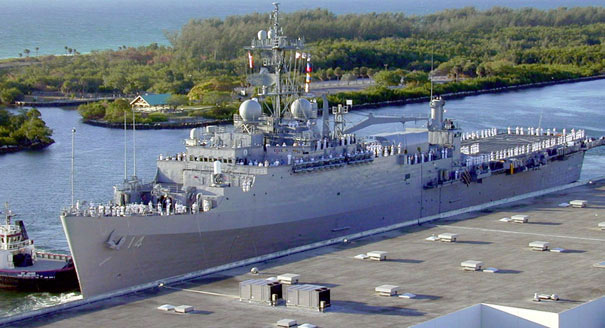Source: Excerpt from The Rise of the Indian Navy
 A ‘springboard’,1 ‘a central triangle’,2 ‘a never-sinking aircraft carrier’3 – or, for the more dramatic, a ‘dagger’4 plunged deep into the surrounding waters – there has been no dearth of vivid metaphors describing India’s enviable position at the heart of the Indian Ocean. A simple glance at a map should provide ample evidence of India’s maritime destiny.
A ‘springboard’,1 ‘a central triangle’,2 ‘a never-sinking aircraft carrier’3 – or, for the more dramatic, a ‘dagger’4 plunged deep into the surrounding waters – there has been no dearth of vivid metaphors describing India’s enviable position at the heart of the Indian Ocean. A simple glance at a map should provide ample evidence of India’s maritime destiny.
An array of land-driven concerns has, however, since Independence, had a way of dragging India back to shore, thwarting its sporadic thalassocratic ambitions. Blessed by its geography, India is cursed by its neighbourhood. The pan-oceanic vision nurtured under the Raj and shared by great post-Independence figures such as Nehru and K.M. Pannikar5 has been buried under the ‘sacred soil’ of the numerous territorial disputes and festering insurgencies that have convulsed the subcontinent and consumed much of its leadership’s strategic attention for the past six decades. The Indian Navy, arguably the most strategic-minded of the three services, has had to grapple for years with its ‘Cinderella service’6 status, which has left it with but a meagre portion of the defence budget. Having played a mostly peripheral part in most of India’s past conflicts7 the Navy has also been hard pressed to define and justify its role. In such a context, the latest edition of the Indian Maritime Doctrine8 issued by the Naval Headquarters, which builds upon both an earlier version released in 2004 and India’s Maritime Strategy (2007)9 provides a vital insight into how the Navy draws its inspiration and conceives of its present and future mandate in a strategically dynamic era.
This chapter aims to provide a better understanding not only of the Indian Maritime Doctrine but also of the larger context surrounding it. Doctrinal developments do not emerge from a vacuum, and are best understood from both a cultural and organizational perspective. It will be argued that in the Indian context, the nation’s complex civil-military and inter-service relations are key to better gauging some of the motivations underlying the Maritime Doctrine.
The study proceeds in three parts. Section one focuses on the essence of the maritime doctrine itself, as well as on the complex institutional setting which provides its backdrop. The document’s lofty ambitions, when juxtaposed with the study of current realities, suggest that it may be more advocatory and aspirational than genuinely reflective of reality. The second section ventures that India’s naval thought can best be understood as syncretic, with a variety of traditions shaping the service’s vision and evolution.
Four different traditions or schools of thought are identified:
- The Indian Continentalist School, more inward than outward-looking, and which has seldom let maritime issues seep through the mental barrier of the Himalayas.
- The Raj Pan-Oceanic School, developed at the height of the British Empire when the Indian Ocean was unified for the first time as a common strategic space.
- The Soviet school, which is more defensive in orientation, and which focuses largely on the control of chokepoints and area defence.
- The Monrovian School, through which India, in the tradition of most regional powers with enviable maritime positions, seeks to extend sea control over what it perceives to be its maritime backyard.
The third and final section draws on these four models in order to chart out different potential trajectories for the Indian Navy in terms of its organization. Depending on changing geopolitical circumstances and shifts in the institutional makeup of India’s Armed Forces, one, or several of these schools will take pride of place. This will have a sizeable impact on the Indian Navy’s deployment patterns, force structure, and planned future acquisitions.10
1. Ashley Tellis, ‘Securing the Barrack: The Logic, Structure and Objectives of India’s Naval Expansion’, Naval War College Review (Summer 1990): 80.
2. K.M. Panikkar, ‘The Defence of India and Indo-British Obligations’, International Affairs, 22(1) (January1946): 85–90.
3. Zhang Ming, ‘The Malacca Dilemma and the Chinese Navy’s Strategic Choices’, Modern Ships, 274, (October 2006): p. 23.
4. Cheng Ruisheng, ‘Interview: Reflections from China’, Journal of International Affairs, 64(2) (Spring/Summer 2011): 213.
5. Kavalam Madhava Pannikar was an influential Indian diplomat and historian who wrote Mahanesque texts on the role of sea power in Indian history and the need for the country to look seaward. Although he was prolific, his most famous and oft cited work remains India and the Indian Ocean: An Essay on the Influence of Sea Power on Indian History (London: George Allen & Unwin, 1945), p. 9.
6. Admiral Arun Prakash, ‘Is the Future Beneath the Waves?’, Livefist Blog Post, Sunday 21 December 2008, retrievable at: http://livefist.blogspot.com/2008/12/admiral-arun-prakash-is-future-beneath.html.
7. The 1971 conflict, during which the Indian Navy’s Osa class missile boats launched a daring attack on the Karachi harbour constitutes a notable exception.
8. Integrated Headquarters, Ministry of Defence (Navy), INBR-8, Indian Maritime Doctrine, 2009.
9. Integrated Headquarters, Ministry of Defence (Navy), Freedom to Use the Seas: India’s Maritime Military Strategy, 2007.
10. The author would like to thank Professor Sumit Ganguly, Walter C. Ladwig, and an anonymous referee for their helpful comments on an earlier draft, as well as Professor Daniel Deudney for his invaluable assistance in helping him achieve a more profound understanding of military doctrine.
Reprinted by permission of the Publishers from India's Aspirational Naval Doctrine in The Rise of the Indian Navy ed. Ashgate 2012, pp. 55-79 Copyright © 2012.







